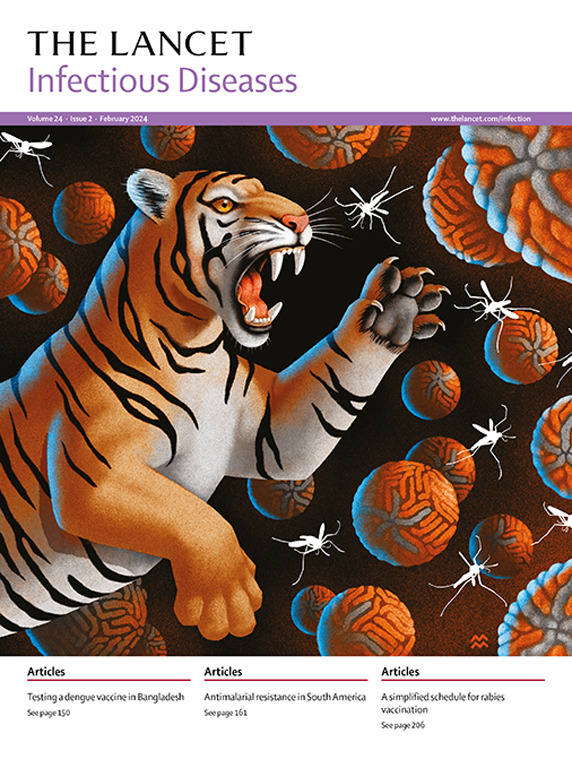Oral treatment of Whipple's disease with doxycycline and hydroxychloroquine versus intravenous therapy with ceftriaxone followed by oral trimethoprim–sulfamethoxazole in Germany: a phase 2/3, prospective, open-label, randomised, controlled, non-inferiority trial
IF 36.4
1区 医学
Q1 INFECTIOUS DISEASES
引用次数: 0
Abstract
Background
Previous studies have shown that intravenous ceftriaxone or meropenem for 14 days, followed by oral trimethoprim–sulfamethoxazole for 1 year, cures 98% of people with Whipple's disease. However, intravenous therapy requires hospitalisation and carries risks for treatment-associated complications. The aim of this study was to investigate whether oral-only treatment for Whipple's disease is non-inferior to intravenous therapy.Methods
This phase 2/3, prospective, open-label, randomised, controlled, non-inferiority trial enrolled individuals aged 18 years or older with confirmed Whipple's disease from across Germany who had received treatment for less than 1 month at Charité–Universitätsmedizin Berlin. Participants were randomly assigned (1:1) with block randomisation to receive either intravenous ceftriaxone (2 g once per day) for 14 days, followed by oral trimethoprim–sulfamethoxazole (960 mg twice per day) for 12 months, or oral doxycycline (100 mg twice per day) plus hydroxychloroquine (200 mg twice per day) for 12 months. Ten participants who had already received intravenous ceftriaxone were non-randomly assigned to the intravenous treatment group. Participants in the oral-only treatment group were PCR-positive for Tropheryma whipplei in cerebrospinal fluid received trimethoprim–sulfamethoxazole (960 mg five times per day) until clearance. The primary outcome was complete clinical remission without recurrence during the observation period of 24 months, assessed in the intention-to-treat (ITT) population. The prespecified non-inferiority margin was –18%. Safety was a secondary endpoint, assessed in the ITT population. The study was registered with the EU Clinical Trials Register, EudraCT 2008–003951–54, and is completed.Findings
Between May 26, 2010, and Oct 30, 2018, we screened 310 individuals and enrolled 64 participants in the study. After exclusion of four individuals whose diagnosis was not confirmed, 31 participants were assigned to the intravenous treatment group and 29 to the oral-only treatment group. By ITT, 25 (81%) of 31 participants in the intravenous treatment group and 28 (97%) of 29 participants in the oral-only treatment group had complete clinical remission without recurrence. The risk difference was 15·9 percentage points (95% CI –1·2 to 33·1), with the lower bound of the 95% CI above our non-inferiority margin of –18%. A post-hoc per-protocol analysis confirmed the non-inferiority of oral-only treatment. No participant relapsed, but two participants in the intravenous treatment group died from nosocomial infections. Serious adverse events occurred in 13 (42%) of 31 participants in the intravenous treatment group and eight (28%) of 29 participants in the oral-only treatment group, but this difference was not statistically significant (p=0·244).Interpretation
Oral-only treatment of Whipple's disease was safe and non-inferior to sequential intravenous–oral treatment. Oral treatment facilitates patient management and might reduce hospital-acquired treatment complications and costs.Funding
German Research Foundation and the Robert Koch Institute.Translation
For the German translation of the abstract see Supplementary Materials section.在德国,多西环素和羟氯喹口服治疗惠普尔病与头孢曲松静脉注射治疗再口服三甲氧苄氨嘧啶-磺胺甲噁唑治疗的对比:2/3 期、前瞻性、开放标签、随机对照、非劣效试验
本文章由计算机程序翻译,如有差异,请以英文原文为准。
求助全文
约1分钟内获得全文
求助全文
来源期刊

Lancet Infectious Diseases
医学-传染病学
CiteScore
60.90
自引率
0.70%
发文量
1064
审稿时长
6-12 weeks
期刊介绍:
The Lancet Infectious Diseases was launched in August, 2001, and is a lively monthly journal of original research, review, opinion, and news covering international issues relevant to clinical infectious diseases specialists worldwide.The infectious diseases journal aims to be a world-leading publication, featuring original research that advocates change or sheds light on clinical practices related to infectious diseases. The journal prioritizes articles with the potential to impact clinical practice or influence perspectives. Content covers a wide range of topics, including anti-infective therapy and immunization, bacterial, viral, fungal, and parasitic infections, emerging infectious diseases, HIV/AIDS, malaria, tuberculosis, mycobacterial infections, infection control, infectious diseases epidemiology, neglected tropical diseases, and travel medicine. Informative reviews on any subject linked to infectious diseases and human health are also welcomed.
 求助内容:
求助内容: 应助结果提醒方式:
应助结果提醒方式:


